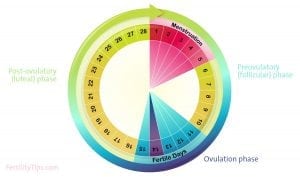Your menstrual cycle is one of the most natural of processes but is biologically one of the most complex and extraordinary events that Mother Nature could ever invent. Being knowledgeable about its phases can not only make it more tolerable but assist your family planning efforts as well.
The four phases of your menstrual cycle
The menstrual phase
 The menstrual phase begins on the first day that you begin bleeding. When you are counting the days of your cycle, this is day number one. The lining of the uterus has been building to a certain thickness, and now the progesterone level that was present begins to decline. This causes the tiny arteries that supply the disposable lining, called the stratum functionalis, to close off, resulting in a sloughing of the entire lining in preparation for the next cycle. The menstrual phase generally occurs from days one to five of a typical 28-day cycle.
The menstrual phase begins on the first day that you begin bleeding. When you are counting the days of your cycle, this is day number one. The lining of the uterus has been building to a certain thickness, and now the progesterone level that was present begins to decline. This causes the tiny arteries that supply the disposable lining, called the stratum functionalis, to close off, resulting in a sloughing of the entire lining in preparation for the next cycle. The menstrual phase generally occurs from days one to five of a typical 28-day cycle.
The preovulatory (follicular) phase
From about days six to 13, after menstruation has ceased, your body will begin producing higher amounts of follicle stimulating hormone (FSH) in order to promote the release of a mature egg from the ovary. Under the influence of FSH, a single (or occasionally two) follicle(s) will emerge on the surface of the ovary. Estrogen levels run high at this time, contributing to higher energy levels and a sense of well-being. These hormones also promote the rebuilding of a new stratum functionalis in preparation for possible implantation by a fertilized egg.
Ovulation
This is the phase you’ve been waiting for! At approximately day 14 of your cycle, the follicle that you’ve been stimulating will rupture from the surface of the ovary and be swept into one of your fallopian tubes. The ovulatory phase is fertilization time. Over-the-counter ovulation predictors, used to detect luteinizing hormone, are sold at most drug stores and can help you track the biochemical march toward ovulation with great accuracy. For anyone trying for a family, a little planning is necessary prior to this phase. Since fertilization actually occurs within the fallopian tubes, it is helpful to have sperm already present when the egg makes its descent. Planning a rendezvous with your partner beginning a few days before and up to one day after your predicted ovulation will maximize your chances of becoming pregnant.
The post-ovulatory (luteal) phase
The events of the post-ovulatory phase depend on whether or not a fertilized egg is achieved. If no fertilization occurs, the hormone cycle will simply repeat itself. If fertilization is successful, the newly fertilized ovum will finish its journey down the fallopian tube and into the uterus, where it can embed itself firmly in the wall of the uterus. Post-ovulation, progesterone levels are on the rise, preparing to destroy the vasculature of the stratum functionalis once again. To halt that process, the fertilized egg produces a hormone called human chorionic gonadotropin, or HCG, the biochemical detected in home pregnancy tests. HCG will increase exponentially each day during the first trimester, preventing the steps that lead to menstruation and promoting a healthy pregnancy.
Family planning can be tricky, and knowing the stages of your cycle can arm you with some helpful tools. As always, if you are planning a family or are having difficulty doing so, always consult your physician to determine any underlying issues and learn to proceed with a safe and healthy pregnancy.





